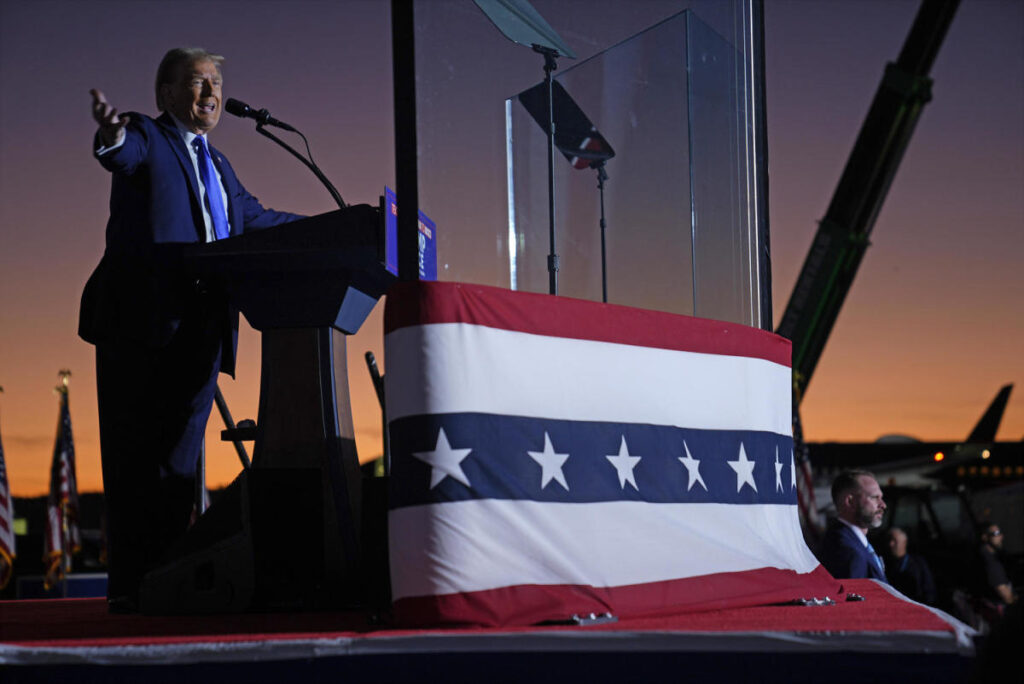Former President Donald Trump made headlines during a rally in Latrobe, Pennsylvania, where he viciously disparaged Vice President Kamala Harris, referring to her as a “s— vice president.” This remark punctuated his ongoing narrative that Harris embodies an extreme liberal ideology, furthering the aggressive rhetoric that has become characteristic of his campaign style. Trump characterized Harris as being to the left of Bernie Sanders, urging the crowd to express their dissatisfaction with her by proclaiming, “Kamala, you’re fired.” His use of vulgarity was intended to add emphasis to his claims about Harris’s competence, which he frequently undermines by calling her “not a smart person” or insinuating she possesses a “low IQ.”
Amidst Trump’s attacks, Harris campaigned in Atlanta, criticizing Trump for what she described as his rambling, scriptless public speaking style. She mocked his tendency to go off on tangents, which he himself dubbed “the weave,” labeling it “nonsense.” Additionally, Harris aimed to highlight Trump’s fitness for the presidency by portraying him as increasingly unstable and unhinged. She argued that Americans deserve a leader who is stable and capable, contrasting her image against Trump’s chaotic demeanor in public appearances. This back-and-forth exchange underscores the escalating personal hostilities that define the final weeks of the race.
Maintaining focus on his campaign strategy, Trump animated his rally by recalling anecdotal stories about the late golfer Arnold Palmer, after whom the airport was named. One particularly bizarre comment he made about Palmer’s anatomy drew immediate criticism, prompting the Harris campaign to respond with incredulity. Campaign spokesperson Sarafina Chitika even suggested that a “wellness check” might be in order for Trump, illuminating the growing concern about his rhetoric as the campaign intensifies. Harris’s team utilized the opportunity to emphasize the inane focus of Trump’s remarks as an indicator of his inability to address pressing voter issues.
Polling data revealed a close race, with an NBC News poll indicating a tie at 48% nationally between Trump and Harris, while state-level polls have shown them neck-and-neck in key battlegrounds like Pennsylvania. This closeness reflects the high stakes for both candidates, as they vie for the support of undecided voters. Harris’s strategies have focused on painting Trump as out of touch and fatigued, framing his recent cancellations of interviews and appearances as signs of weakness. In response to the narrative that President Joe Biden shows signs of incapacity, Harris flipped the script, questioning Trump’s stamina for the arduous demands of the presidency.
Harris aimed to draw attention to the challenges inherent in holding the highest office, suggesting that Trump’s recent behavior could compromise his ability to perform effectively as president. During remarks in Michigan, she stressed how the job is one of extreme difficulty and implicitly questioned whether Trump has the necessary energy and mental agility to lead. This strategic pivot highlights how Harris’s campaign seeks to directly challenge Trump’s narratives while simultaneously reinforcing her own qualifications for the role.
In closing, the dynamic of the current race remains charged, with personal invective and public characterizations taking center stage. Trump’s deployment of crude language and hyperbolic assertions marks an escalated strategy in a tightly contested election season. Meanwhile, Harris’s response strategy includes both counterattacks and attempts to redefine the conversation surrounding fitness for office in relation to Trump’s behavior. As the campaign unfolds, both candidates are likely to continue engaging in this high-stakes duel of personalities, signaling what could be a decisive moment in American political history. The outcome will hinge not only on policy discussions but increasingly on the public’s perception of each candidate’s character and viability for leadership.

